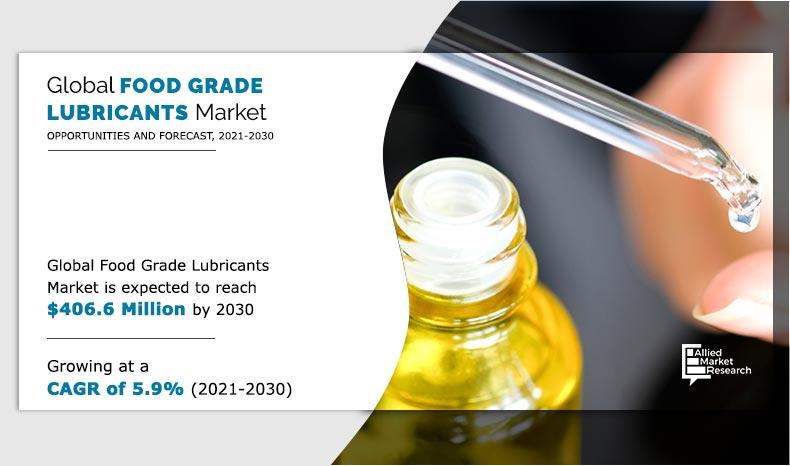Food Grade Lubricants Market Research, 2031
The global food grade lubricants market size was valued at $230.4 million in 2020, and is projected reach $406.6 million by 2030, registering a CAGR of 5.9% from 2021 to 2030.
Food grade lubricants perform same functions as any other lubricant, including but not limited to providing protection against friction, corrosion, wear, oxidation, dissipating heat power transmission as well as providing a sealing effect in some cases. However, food grade lubricants are considered safe for incidental contact with items that are consumed by animals or humans, as long as they do not exceed a certain concentration. Food grade lubricants are widely used in food, beverages, and pharmaceutical industries.
Market Dynamics
The food processing industry has seen an increase in the demand for food-grade lubricants due to heightened awareness around food safety and hygiene. Food-grade lubricants are critical in preventing contamination during the manufacturing and processing of food products, ensuring they meet safety regulations. The rising consumer preference for high-quality, safe, and hygienic food products has prompted manufacturers to prioritize the use of non-toxic, food-safe lubricants. Regulations such as those set by the FDA and NSF (National Sanitation Foundation) have made the use of food-grade lubricants mandatory in various food processing applications, further driving the food grade lubricants market.
As global food production expands and technology in processing equipment improves, the need for specialized lubricants that can withstand high temperatures, extreme pressure, and wet conditions in the food processing environment grows. The increasing production and packaging demands globally are expected to continue fueling food grade lubricants market growth in this sector.
As consumers become more health-conscious, there is an increasing demand for food products free from contamination by hazardous chemicals and substances. Regulatory bodies such as the U.S. FDA, European Food Safety Authority (EFSA), and NSF International have implemented strict guidelines that require the use of food-grade lubricants in food processing plants and facilities. These regulations ensure the safety and quality of food products while maintaining high hygiene standards throughout production. Food-grade lubricants are formulated to meet specific food safety criteria, including being free from harmful chemicals, synthetic oils, and additives that could negatively impact food quality.
The primary restraints in the food-grade lubricants market is the relatively high cost of these specialized lubricants compared to conventional lubricants. Food-grade lubricants are formulated with pure, non-toxic ingredients and undergo rigorous testing and certification processes to meet food safety standards. This quality assurance process, along with the higher cost of production, makes food-grade lubricants more expensive. For food manufacturers, particularly small- and medium-sized businesses, the higher cost can act as a significant barrier to adopting these lubricants. Additionally, the cost of switching from traditional lubricants to food-grade alternatives might include extensive retraining, requalification of equipment, and additional inventory management, further increasing expenses. Despite the advantages of food-grade lubricants in terms of safety and compliance, many companies in the food industry may hesitate to adopt them due to the financial burden. Overcoming this cost constraint is critical for the continued growth of the market.
While the demand for food-grade lubricants is on the rise, the availability of specialized lubricants tailored for specific food processing requirements remains limited. Food-grade lubricants need to fulfill various performance requirements, such as high oxidation stability, resistance to corrosion, and the ability to perform well under high temperatures, moisture, and pressures. However, not all food processing sectors have access to lubricants that meet these unique needs, especially in highly specialized food production applications like bakery, confectionery, and dairy processing. This creates a gap in the market, preventing manufacturers from fully utilizing the potential of food-grade lubricants. The lack of customization and diversity in available products can pose a challenge for food manufacturers seeking tailored lubrication solutions that meet their specific needs, whether it be in terms of viscosity, temperature tolerance, or durability.
The increasing global demand for processed and packaged food presents a substantial opportunity for the food-grade lubricants market. With more consumers seeking convenience, ready-to-eat meals, and packaged food products, the food processing and packaging industries are expanding rapidly. Food-grade lubricants are essential in ensuring the smooth operation of machinery used in food processing, filling, sealing, and packaging processes. As food production increases to meet consumer demand, the use of food-safe lubricants will become more critical in ensuring product quality, safety, and equipment longevity. Moreover, innovations in packaging materials and processing technologies, such as automation in food manufacturing and packaging lines, require specialized lubricants that can withstand high-speed operations and extreme conditions. This growing need for efficient and safe production processes offers significant growth potential for food-grade lubricant manufacturers.
Segment review
The global food grade lubricants market is segmented on the basis of type, form, application, and region. Based on type, the global market is bifurcated into mineral oil and synthetic. By form, the market is divided into oil and grease. By application, the market is divided into food, beverages, pharmaceuticals, and others. Region-wise, the market is also analyzed across North America, Europe, Asia Pacific, and LAMEA.
By Type
By type, mineral oil lubricants dominated the food grade lubricants market in 2020. It is made from petroleum-based white oil while synthetic lubricants are much more processed and chemically altered form of white oil or silicone. Mineral oil food grade lubricants are most commonly used as they are cheaper and readily available. The synthetic segment is expected to gain market share during the forecast period, owing to its superior performance characteristics compared to its counterparts.
By Type
Synthetic segment would exhibit the highest CAGR of 7.1% during 2021-2030.
By Form
By form, lubricant oil dominated the food grade lubricants market in 2020. It is a viscous liquid that is applied to machinery to reduce friction and wear & tear of the machinery. It is used for applications that require higher level of penetration and has no risk of excessive leakage. Food grade lubrication grease is a semi-solid lubricating agent. It is useful for application in components that are not very intricate and do not require very deep penetration. It can be used in open to air systems as well.
By Form
Oil segment would exhibit the highest CAGR of 6.0% during 2021-2030.
By Application
By application, the food industry dominated the food grade lubricants market in 2020. It leads in terms of market share and is expected to retain its dominance, owing to strict food safety regulations across the developed and developing countries.
By Application
Food segment would exhibit the highest CAGR of 6.9% during 2021-2030.
By Region
Region-wise, the North America dominated the market in 2020. It is expected to lead in terms of food grade lubricants market share in 2021; however, Asia-Pacific is poised to grow with the highest CAGR during the forecast period. Expansion of food processing industry in the Asia-pacific region to provide lucrative opportunities for the engaged stakeholders.
By Region
Asia-Pacific region would exhibit the highest CAGR of 7.5% during 2021-2030.
Competitve Analysis
The key players profiled in the food grade lubricants market analysis include Brit-Lube, Clearco Products Co., Inc, Freudenberg Group, Fuchs Group, HollyFrontier Corporation, Hydrotex Lube, Interflon, Lubriplate Lubricants Company, Metalube, and SKF Group. Other prominent players analyzed in the report are BP PLC, International Products Corporation, David Weber Oil Co, Exxon Mobil Corporation, Total Specialties, Condat, and Repsol.
Key Benefits For Stakeholders
The report provides an extensive analysis of the current and emerging food grade lubricants market trends and opportunities.
The report provides detailed qualitative and quantitative analysis of the current trends and future estimations that help evaluate the prevailing food grade lubricants market opportunities in the market.
The food grade lubricants market forecast is offered along with information related to key drivers, restraints, and opportunities.
The market analysis is conducted by following key product positioning and monitoring the top competitors within the food grade lubricants industry framework.
The report provides extensive qualitative insights on the potential and niche segments or regions exhibiting favorable growth.
Food Grade Lubricants Market Report Highlights
| Aspects | Details |
| By TYPE |
|
| By FORM |
|
| By APPLICATION |
|
| By Region |
|
| Key Market Players | SKF GROUP, HYDROTEX LUBE, FREUDENBERG, .LUBRIPLATE LUBRICANTS COMPANY., INTERFLON, CLEARCO PRODUCTS CO., INC, FUCHS, BRIT-LUBE LTD, HOLLYFRONTIER CORPORATION, METALUBE |
Analyst Review
With growing eminence of food safety and standards, the necessity of food grade lubricants has increased manifolds. Changing consumer behavior regarding food safety and standards, owing to COVID-19 pandemic has further resulted in increased demand for high-quality products translating into increased demand for food grade lubricants. Nevertheless, the market is expected to witness the introduction of new players along with innovative solutions for lubrications. With novel innovations, recent years have witnessed increased demand for synthetic lubricants having superior properties as compared to its counterparts such as mineral lubricants.
Attributed to stringent regulations regarding food processing in North America and Europe, high demand for food grade lubricants has been witnessed presently. However, developing countries of Asia-Pacific are expected to witness high traction in the coming years, with growing awareness, strict government regulations, and expansion of food & beverages industry in the region.
With existing religious identities, and increasing consumer perception about kosher and halal food as safer, the demand for such food has gained steadily. To cater to such food requirements, engaged stakeholders in the industry are now venturing toward halal and kosher certified food grade lubricants. With new market niche, the players are diversifying their product offerings and untapped new opportunities present in the market.
The global food grade lubricants market size was valued at USD 230.4 million in 2020, and is projected to reach USD 406.6 million by 2030
The global food grade lubricants market is projected to grow at a compound annual growth rate of 5.9% from 2021-2030 to reach USD 406.6 million by 2030
The key players profiled in the reports includes Brit-Lube, Clearco Products Co., Inc, Freudenberg Group, Fuchs Group, HollyFrontier Corporation, Hydrotex Lube, Interflon, Lubriplate Lubricants Company, Metalube, and SKF Group. Other prominent players analyzed in the report are BP PLC, International Products Corporation, David Weber Oil Co, Exxon Mobil Corporation, Total Specialties, Condat, and Repsol.
Asia-Pacific dominated in 2021 and is projected to maintain its leading position throughout the forecast period.
Increased Focus on Food Safety and Hygiene, Expansion of the Food Processing Industry, Rising Consumer Awareness and Health Concerns, Regulatory Pressures and Safety Standards, Technological Innovation in Lubricants, High Demand for Processed and Packaged Foods majorly contribute toward the growth of the market.
Loading Table Of Content...




